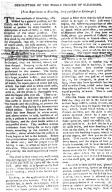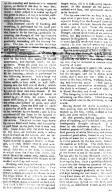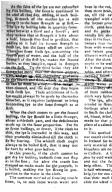[ Description of the Whole Process of Bleaching ]
Date: 1792/02/13
Source:
Nova Scotia Magazine
Institution: Nova Scotia Archives
| Source Origin: Nova Scotia Newspapers on Microfilm
| Reference: Microfilm Reels 8062, 8063
Instructions on how to wash coarse and fine linen. Vol. 5, pp. 112-13. Microfilm Reel 8063.
DESCRIPTION OF THE WHOLE PROCESS OF BLEACHING
[From Experiments on Bleaching, lately published at Edinburgh]
THE two methods of bleaching, esta-
blished by a general practice, are the
Dutch, and the Irish; one or the other is fol-
lowed at present by every bleacher. A
description of each of these, is then a de-
scription of the whole practice. The
Dutch method is that much followed for
fine cloth by the skilful bleachers; while,
for cheapness, they use, in the whitening
of coarse cloth, the Irish method, or one
very like it. I shall then give a short de-
scription of the facts which happen in each.
The Dutch method is as follows.
After the cloth has been sorted into
parcels of an equal fineness, as near as can
be judged, they are latched, linked, and
then steeped. Steeping is the first opera-
tion which the cloth undergoes, and is
performed in this manner. The linens
are folded up, each piece distinct, and laid
in a large wooden vessel; into which is
thrown, blood warm, a sufficient quantity
of water, or equal parts of water and lye,
which has been used to white cloth only,
or water with rye meal or bran mixed
with it, till the whole is thoroughly wet,
and the liquor rises over all. Then a co-
ver of wood is laid over the cloth, and
that cover is secured with a post betwixt
the boards and the joisting, to prevent the
cloth from rising during the fermentation
which ensues. About six hours after the
cloth has been steeped in warm water,
and about twelve in cold, bubbles of air
arise, a pellicle is formed on the surface of
the liquor, and the cloth swells when it is
not pressed down. This intestine motion
continues from thirty-six to forty-eight
hours, according to the warmth of the
weather; about which time the pellicle or
scum begins to fall to the bottom. Before
this precipitation happens, the cloth must
be taken out; and the proper time for
taking it out, is when no more air-bub-
bles arise. This is allowed to be the just-
est guide by the most experienced bleach-
ers.
The cloth is then taken out, well rinsed,
disposed regularly by the selvage, and wash-
ed in the pot-mill to carry off the loose
dust. After this it is spread on the field
to dry; when thoroughly dried, it is rea-
dy for bucking; which is the second ope-
ration.
Bucking, or the application of salts, is
performed in this manner. The first, or
mother-lye, is made in a copper, which
we shall suppose, for example, when full,
holds 170 Scots gallons of water. The
copper is filled three fourths full of water,
which is brought to boil: Just when it
begins, the following proportion of ashes
is put into it, viz. 30 pounds of blue, and
as much white pearl ashes; 200 pounds
of Marcroft ashes (or, if they have not
these, about 300 pounds of Cashub) 300
pounds of Muscovy, or blanch-ashes; the
three last ought to be well pounded. This
liquor is allowed to boil for a quarter of
an hour, stirring the ashes from the bot-
tom very often; after which the fire is ta-
ken away. The liquor must stand till it
it has settled, which takes at least six hours
and then it is fit for use.
Out of their first, or mother lye, the
second, or that used in bucking, is made
in this manner. Into another copper
holding, for example, 40 Scots gallons,
are put 38 gallons of water, two pounds
of soft soap, and two gallons of mother
lye; or, for cheapness, in place of the
soap, when they have lye which has been
used to white linen, called white linen lye,
they take 14 gallons of it, leaving out an
equal quantity of water. This is called
bucking lye.
After the linens are taken up from the
field dry, they are set in the vat or cave,
as their large vessel is called, in rows, end-
ways, that they may be equally wet by the
lye; which, made blood warm, is now
thrown on them, and the cloth is after-
wards squeezed down by a man with
wooden shoes. Each row undergoes the
same operation, until the vessel is full, or
all the cloth in it. At first the lye is put
on milk warm, and after standing a little
time on the cloth, it is again let off by a
cock into the bucking copper, heater to a
greater degree, and then put on the cloth
again. This course is repeated for six or
seven hours, and the degree of heat gra-
dually increased, till it is at the last turn
or thrown on boiling hot. The cloth re-
mains after this for three or four hours in
the lye; after which the lye is let off,
thrown away, or used in the first buckings,
and the cloth goes on to another opera-
tion.
The cloth is then carried out, generally
early in the morning, spread on the grass,
pinned, corded down, exposed to the sun,
and air, and watered for the first six hours,
so often, that it never is allowed to dry.
Afterwards it is allowed to lie till dry
spots appear before it is watered. After
seven at night it gets no more water, un-
till it be a very drying night. Next day
in the morning and forenoon it is watered
twice, or thrice if the day is very dry;
but if the weather be not drying it gets no
water: After which it is taken up dry if
the green is clean; if not, it is rinsed, mill-
washed, and laid out to dry again, to be-
come fit for bucking.
This alternate course of bucking and
watering, is performed for the most part
from ten to sixteen times, or more, before
the linen is fit for souring; gradually in-
creasing the strength of the lye from the
first to the middle bucking, and from that
gradually decreasing till the souring be-
gins. The lyes in the middle buckings
are generally about a third stronger than
the first and last.
Souring, or the application of acids to
cloth, is the fourth operation. It is diffi-
cult to say when this operation should
commence, and depends mostly on ex-
perience. When the cloth has an equal
colour, and is mostly freed from the sprat,
or outer bark of the lint, it is then thought
fit for scouring; which is performed in
the following manner. Into a large vat
or vessel is poured such a quantity of
butter milk, or sour milk, as will suffi-
ciently wet the first row of cloth; which
Is tied up in loose folds, and pressed down
by two or three men bare-footed. If the
milk is thick, about an eight of water is
added to it; if thin, no water. Sours
made with bran, or rye meal and water,
are often used instead of milk, and used
milk warm. Over the first row of cloth
a quantity of milk and water is thrown,
to be imbibed by the second; and so it is
continued till the linen to be scoured is
sufficiently wet, and the liquor rises over
the whole. The cloth is then kept down
by covers filled with holes, and secured by
a post fixed to the joist, that it may not
rise. Some hours after the cloth has been
in the sour, air bubbles arise, a white
scum is found on the surface, and an in-
testine motion goes on in the liquor. In
warm weather it appears sooner, is stron-
ger, and ends sooner than in cold wea-
ther. Just before this fermentation,
which lasts five or six days, is finished,
at which time the scum falls down, the
cloth should be taken out, rinsed, mill-
washed, and delivered to the women to be
washed with soap and water.
Washing with soap and water is the fifth
operation; and is performed thus. Two
women are placed opposite at each tub,
which is made of very thick staves so that
the edges which slope inwards are about
four inches in thickness. A small vessel
full of warm water is placed in each tub.
The cloth is folded so that the selvage may
be first rubbed with soap and warm water
length ways, till it is sufficiently impreg-
nated. In this manner all the parcel is
rubbed with soap, and afterwards carried
to be bucked.
The lye now used has no soap in it, ex-
cept what it gets from the cloth; and is
equal in strength to the strongest formerly
used, or rather stronger, because the cloth
is now put in wet. From the former
operation these lyes are gradually made
stronger, till the cloth seems of an uniform
white, nor any darkness of an uniform
white, nor any darkness or brown colour
appears in its ground. After this the lye
is more speedily weakened than it was in-
creased; so that the last which the cloth
gets, is weaker than any it got before.
But the management of sours is different;
so they are used strongest of first and de-
creased so in strength, that the last sour,
considering the cloth is then always taken
up wet, may be reckoned to contain three
fourths of water.
From the bucking it goes to the water-
ing, as formerly, observing only to over-
lay the selvages, and tie it down with
cords, that it may not tear: then it re-
turns to the sour, milling, washing, buck-
ing, and watering again. These opera-
tions succeed one another alternately till
the cloth is whitened; at which time it
is blued, starched, and dried.
The foregoing is the method used in the
whitening our fine cloths. The following
is the method used in the whitening of the
coarse.
Having sorted the cloths according to
their quality, they are steeped in the same
manner as the fine, rinsed, washed in the
mill, and dried before boiling.
In this process, boiling supplies the
place of bucking, as it takes less time, and
consequently thought cheapest. It is
done in the following manner: Two
hundred pounds of Cashub ashes, one hun-
dred pounds of white Muscovy, and thirty
pounds of pearl-ashes, boiled in 105 Scots
gallons of water for a quarter of an hour,
as in the process for the fine cloth, makes
the mother or first lye. The cloth-boiler
is then to be filled two-thirds full with
water and mother lye, about nine parts
of the former to one of the latter; so that
the lye used for boiling the coarse cloth, is
about a third weaker than that used in
bucking the fine. Such a quantity of cloth
is put into the foregoing quantity of lye,
when cold, as can be well covered by it.
The lye is brought gradually to the boil,
and kept boiling for two hours; the cloth
being fixed down all the time, that it does
not rise above the liquor. The cloth is
then taken out, spread on the field, and
watered, as mentioned before in the fine
cloth.
As the salts of the lye are not exhausted
by this boiling, the same is continued to
be used all that day, adding, at each boil-
ing, so much of the mother-lye as will
bring it to the same strength as at first. --
The lye by boiling loses in quantity some
what betwixt a third and a fourth; and
they reckon that in strength it loses about
a half, because they find in practice, that
adding to it half its former strength in
fresh lye, has the same effect on cloth. --
Therefore some fresh lye, containing the
fourth part of water, and the half of the
strength of the first lye, makes the second
boiler, as they imagine, equal in strength
to the first. To the third boiler they add
somewhat more than the former propor-
tion, and go on still increasing gradually
to the fourth and fifth, which is as much
as can be done in a day. The boiler is
then cleaned, and the next day they begin
with fresh lye. These additions of fresh
lye ought always to be made by the master
bleacher, as it requires judgement to bring
succeeding lye to the same strength as at
first.
When the cloth comes to get the second
boiling, the lye should be a little stronger,
about a thirtieth part, and the deficiencies
made up the same proportion. For six
or seven boilings, or fewer, if the cloth be
thin, the lye is increased in this way, and
then gradually diminished till the cloth is
fit for souring. The whitest cloth ought
always to be boiled first, that it may not
be hurt by what goes before.
In this process, if the cloth cannot be
got dry for boiling, business does not slop
as in the fine; for after the coarse has
dreeped on racks made for the purpose, it
is boiled, making the lye strong in pro-
portion to the water in the cloth.
The common method of scouring coarse
linen, is, to mix some warm water and
bran in the vat, then put a layer of cloth,
then more bran, water, and cloth, and so
on, till the cave is full. The whole is
trampled with men’s feet, and fixed as in
the former process. A thousand yards of
cloth, yard-broad, require betwixt four
and six pecks of bran. The cloth ge-
nerally lies about three nights and two
days in the sour. Others prepare their sour
twenty four hours before, by mixing the
bran with warm water in a separate vessel;
and before pouring it on the cloth, they
dilute it with a sufficient quantity of water.
After the cloth is taken from the sour, it
ought to be well washed and rinsed again.
It is then given to men to be soaped on a
table, and afterwards rubbed betwixt the
rubbing board. When it comes from
them it should be well milled, and
warm water poured on it all the time, if
conveniency will allow of it. Two or three
of these rubbings are sufficient, and the
cloth very seldom requires more.
The lye, after sourings begins, is de-
creased in strength by degrees, and three
boilings after that commonly sufficiently
to finish the cloth. Afterwards it is starch-
ed, blued, dried, and beetled in a machine
made for that purpose, which supplies the
place of a calender, and is preferred by many
to it.
This method used in the bleaching of
our coarse cloths, is very like that practised
in Ireland for both fine and coarse. The
only material difference is that there the
bleachers use no other ashes but the kelp
or Cashub. A lye is drawn from the for-
mer by cold water, which dissolves the salts
and not the sulphureous particles of the
kelp ashes. This lye is used till the cloth
is half whitened, and then they lay aside the
kelp lye for one of Cashub ashes. I am told
that their most skillful bleachers have laid
aside the use of the kelp ashes.
Download: Transcription | Images


